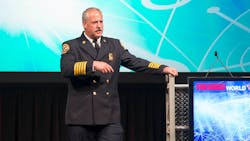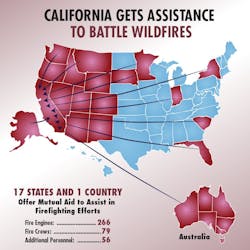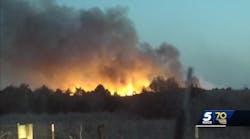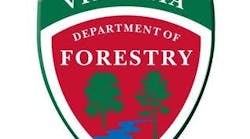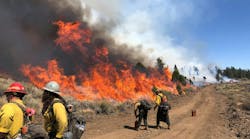It was the perfect storm in so many ways last fall. Winds that hadn’t been recorded in decades. Dozens of brush fires that started late in the evening as people were already asleep. California’s massive number of resources stripped bare. Technology outages that left civilians and firefighters without communications abilities.
Firefighters from two countries would be called out to help contain the brush fires that spread across the state, as four of the state’s 20 worst fires occurred in the region at the same time on Oct. 20.
Cal Fire Director Ken Pimlott, Santa Rosa Fire Chief Tony Gossner and California State Fire and Rescue Chief Kim Zagarias spoke about the fires during the Firehouse World Extra Alarm Session Thursday morning.
Between Oct. 8–11, Northern California suffered from 172 fires, 21 which were considered large fires. Those fire resulted in 44 deaths and 8,900 structures being damaged.
The Tubb’s Fire, which started in Calistoga and burned into Santa Rosa, is now the state’s largest fire in history.
Before the fire
Gossner referred back to the 1964 Hanly Fire that burned almost the same path as the Tubbs Fire. The earlier fire took four days to spread the same distance that the Tubbs Fire covered in just four hours.
Between 2012 and 2015, California saw its worst drought in 1,200 years. The entire state was a tinder box with dry and dead vegetation and trees.
Before the October fires, the state had seen a record number of fires during 2017, despite the fact that 2016–17 was the wettest period on record in the state. While that precipitation was helpful in many ways, it promoted the growth of the flashy fuels that played a major role in the fires.
“We were seeing records…the combustion potential and the BTUs were off the charts,” Pimlott said.
Crews were already preparing as forecasters touted mountain wave winds, which carry winds in excess or 50 miles up and over mountain ranges.
“It’s a bit cliché, but we keep hearing this is the new normal and the reality is, it is the new normal,” Pimott said.
Santa Rosa burning
Gossner said it was a busy night for firefighters in Santa Rosa as the winds blew it, but they had no idea what was in store for them.
Earlier in the evening, he drove along Tubbs Lane and observed winds, but nothing out of the ordinary.
Between 6 p.m. and midnight, Santa Rosa crews handled dozens of calls including 20 vegetation fires and 10 structure fires – including one that reached three alarms. Mutual aid resources were called in from the area to help them battle the various fires.
Gossner responded to the three-alarm structure fire and as he was leaving, a chief told him about two homes burning in an adjacent community. When he radioed his dispatch center that he was responding to those fires, they informed him that no fires were reported at the time.
He drove to a high point in the community to evaluate the situation.
“I decided to take a look and see what was going on because there was really no situational awareness for me since I just came (back) in to town,” Gossner said. “I’ll tell you, within 30 minutes, there were five fires dispatched in our area.”
A captain contacted Gossner and asked if they should do a recall. All but four members returned to staff spare apparatus.
The department mechanics drove to a repair facility to retrieve an apparatus that was undergoing maintenance and it was placed back in service.
“It was all hands on deck.”
Gossner contacted the city manager and said the city’s emergency operations center needed to be activated because the fire was approaching the city. After he left a meeting with area fire chiefs, he came across two cars burning at an intersection, but nobody was around.
“You don’t see that every day…you don’t see smoke, fire or anything.” He later determined that people were driving through the fires to escape and then leaving their cars as they burst into flames.
With outside resources being requested, he set up unified command at a Kmart store where a large parking lot provided ample room for staging.
By 1 a.m. the fire was burning into the Fountaingrove neighborhood that is filled expensive homes just across Highway 101 from downtown Santa Rosa.
A task force was dispatched to that area, but the fire quickly blew up and overwhelmed crews. The fire destroyed two large hotels, dozens of homes and moved into a large mobile park.
“I had no resources, everyone was doing what they needed to do. There was no resources left to do anything.” He called his dispatcher center and requested help, “Their response was 'there is no one. You’re on your own until outside resources come.’”
He said he was unaware of the Nuns Fire burning in Sonoma Valley and had no operational view of what was going on in the region.
As he sat in his command vehicle at Kmart, he saw a fire at nearby building and realized the command post was in the path of the fast-moving blaze and they moved out to a fire station.
Another report indicated that the fire jumped the six-lane Highway 101 and fire was consuming apartment complexes. “That’s just a quarter-mile from the city,” he said.
Gossner said the fire travelled over 13 miles from the country into the city in just three hours. The fire burned two miles into the city.
“I’ll tell you folks, we had a five-mile wide front hit us…you’re dealing with that type of destruction,” Gossner said “It was just so large, we couldn’t do anything to keep up with it.”
Dozens of fires reported
“In just a couple-day period, they almost doubled the amount of acres burned during the rest of the year,” Zagaris said. The state’s emergency operations center was activated more days in 2017 than it had been since it opened.”
Pimlott contacted the state’s Office of Emergency Services and the governor’s office to brief them after he was brought up to speed about 12:30 a.m. Following that, he received dozens of calls from various agencies, legislators and others looking for details.
“All of it was pouring in to the fact that we had a disaster brewing,” Pimlott said.
Other fires near the Tubbs Fire included the Nuns Fire in Sonoma County, the Atlas Fire in Napa County and the Pocket Fire in Sonoma County.
The state’s emergency operations center was open by 6:30 a.m. to evaluate and dispatch resources.
Pimlott said the state activated four of the six Type 1 Incident Management Teams (IMTs) to different areas to help coordinate requests and manage the incidents.
Several local government Type 3 IMTs were also deployed in various roles and he said that add level of experience helped take some of the weight off the Type 1 teams.
One of the Type 3 teams was used to coordinate two evacuations for a group of mentally disabled residents who were in need of continuous medical care, including the use of medical machines.
“I will tell you that I’ve spent the last 30 of my 40 years managing our state’s mutual aid system,” Zagaris said. “We’re adjusting and we’re struggling in some areas.”
Firefighters responded from 17 states and Australia. In addition, over 4,300 law enforcement officers were called in to help with traffic control, evacuations, and other tasks. The California National Guard put 2,300 soldiers on the ground to assist with various tasks.
“It was just a phenomal effort,” Zagaris said.
Community outreach
All three stressed the importance of having multiple warning systems in place to inform residents about evacuations. Officials were unable to use reverse 9-1-1 for many residents because the telephone and voice over internet protocol (VOIP) services went down early due to the strong winds.
“I know you guys have a community that will have the same situation someday,” Gossner said. “I can’t stress this enough. If you have an opt-in system for evacuation notifications…it’s not a great tool for a fast-moving fire.” He also said visitors in town would not have received the notifications.
Officials are looking to upgrade the warning systems and add red flag warnings so citizens are aware of the heightened fire threats.
“If you don’t know the amber alert system, figure it out. I’m telling you, you need to use it,” Gossner said of the technology that’s used to alert residents by geographic locations.
When officials met with community members after the fires were contained, they had a lot of questions.
“Community meetings were very difficult and people want to know information,” Gossner said.
He said you need to be upfront and honest and even if you don’t have an answer for their question, you need to tell them that.
The damage
Twenty-two people perished in the Tubbs Fire and over 5,600 structures were damaged. Five percent of Santa Rosa’s housing stock was destroyed by the blaze.
One of Santa Rosa’s fire stations, which Gossner said was built to withstand WUI fires, was destroyed by the flames.
Gossner shared how the Fountaingrove neighborhood was named a Firewise Community. The program, hosted by the NFPA, is designed to have residents work throughout their community to reduce the risk from fires through prevention efforts.
Gossner said one firefighter suffered minor injuries.
“These are no longer the fires of the future, these are the fires of the present,” Pimlott said. “We need to prepare on all aspects, from prevention and training to equipment and response.”
